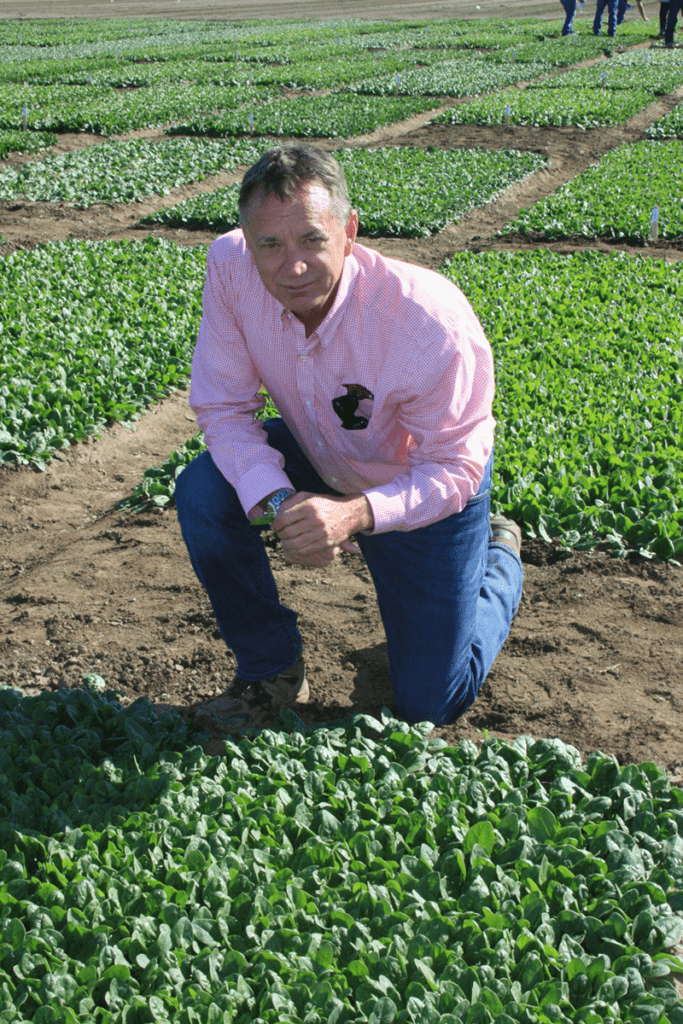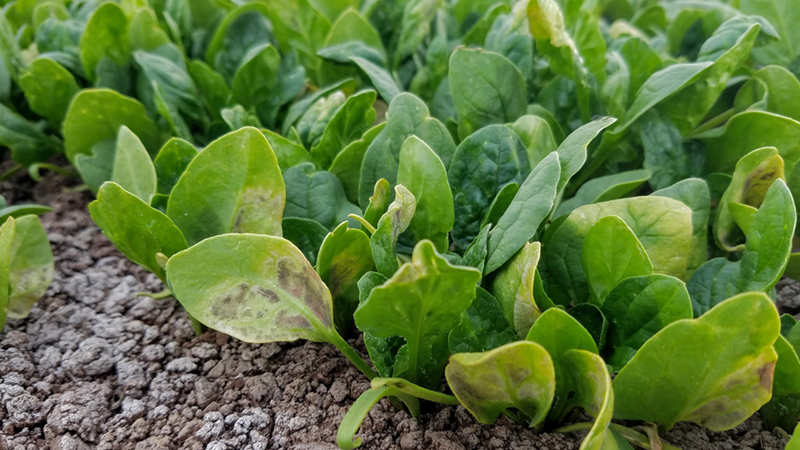Nov 13, 2024Evolving downy mildew strains test spinach growers
Most afternoons, a coastal breeze blows in from Castroville to King City, cooling the Salinas Valley and supporting a wide range of vegetable crops from artichokes to broccoli to spinach.
U.S. Department of Agriculture researchers say spore traps placed throughout the region confirm that the breeze also carries spinach downy mildew spores, transporting a persistent plant-disease challenge for growers.
As a result, researchers and growers in the region are constantly working to develop and plant new spinach varieties that offer broad resistance to ever-evolving strains of spinach downy mildew.
As the most widespread spinach disease in California, the pathogen can spread rapidly in cool, wet conditions, curling and blighting leaves while causing extensive crop damage.
Jim Correll, a University of Arkansas plant pathologist specializing in spinach research, told the California Leafy Greens Research Board Conference that incidents of spinach downy mildew disease have remained low in recent growing seasons thanks to continued success in developing resistant spinach varieties. Yet, the disease also continues to reinvent itself.

In the 2022-23 season, Correll said, researchers identified 19 distinct races of the crop disease. In May, the International Working Group on Peronospora on spinach designated a 20th race of downy mildew.
While spore traps can confirm the presence of the disease before Salinas Valley crops show any symptoms, researchers say they can’t immediately tell which race of the disease is in the area.
“The latest monitoring tools do not tell what race is present, and we are still searching for race-specific markers,” said Steve Klosterman, a USDA senior researcher based in Salinas.
Each new race of spinach downy mildew is designated after researchers find it shows an ability to infect previously resistant spinach varieties. Each new downy mildew discovery creates pressure to develop new spinach varieties.
Under the direction of University of California, Davis, Plant Breeding Center Director Charles Brummer, researchers are working to breed spinach with enduring resistance and the ability to limit uptake of cadmium from the soil, an issue with some spinach varieties.

Brummer’s research group has identified a few promising breeding lines for increased production by seed companies. But researchers have yet to develop a super spinach variety with universal resistance. Salinas Valley growers must constantly adapt by employing new varieties that are resistant to current strains of downy mildew.
As the UC Pest Management Guidelines explain, “the use of resistant cultivars is the most effective means of controlling spinach downy mildew.” The guidelines note that during the past 50 years in California, “each outbreak of a new downy mildew race was later matched by the development of resistant spinach lines.”
Correll has screened spinach varieties for downy mildew resistance in Salinas, San Juan Bautista and Yuma, Arizona, for years. He said each new race of downy mildew is “identified and evaluated against a standard set of spinach differentials” to determine resistance or vulnerability.
The International Working Group on Peronospora concluded that the 20th race of downy mildew “poses a significant threat to the spinach industry in all parts of the world.” Spinach varieties it can infect include Viroflay and Yakalo.
The working group includes growers and pest control advisors in California and Arizona and representatives from seed and breeding companies.
In the Salinas Valley, spinach is largely grown on 80-inch beds that are sprinkler irrigated. The dense canopy is moist and cool. The moist conditions are favorable to downy mildew, which makes itself known through unsightly spots that make the crop unfit to market.
There has been limited research showing that drip irrigation decreases spinach downy mildew pressure. But because the crop is shallow rooted and densely packed, drip irrigation saves little on water or the energy to move it.
Meanwhile, with spinach grown throughout Monterey County, the coastal breeze continues to spread downy mildew spores from field to field.
Klosterman of USDA said researchers placing spore traps in the region have worked with the Oakland pathogen management firm Root Applied Sciences to develop enhanced monitoring to track the disease risks.
In addition, seed companies have been adept at offering resistant varieties to manage the newest races of the disease.
For example, just two days after the working group designated spinach downy mildew race 20, the vegetable breeding company Enza Zaden published a list of its spinach varieties that are resistant to the new race—providing spinach farmers with useful options, at least until the next threat drifts in with the coastal breeze.
— Bob Johnson is a reporter in Monterey County for the California Farm Bureau’s Ag Alert.
















